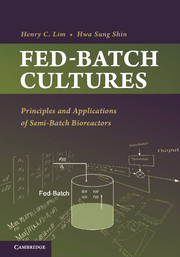Book contents
- Frontmatter
- Contents
- Preface
- Acknowledgments
- 1 Introduction to Fed-Batch Cultures
- 2 Idealized Reactors and Fed-Batch Reactors
- 3 Maximization of Reaction Rates and Fed-Batch Operation
- 4 Phenomena That Favor Fed-Batch Operations
- 5 Classification and Characteristics of Fed-Batch Cultures
- 6 Models Based on Mass Balance Equations
- 7 Non–Equation-Based Models
- 8 Specific Rate Determination
- 9 Optimization by Pontryagin's Maximum Principle
- 10 Computational Techniques
- 11 Optimization of Single and Multiple Reactions
- 12 Optimization for Cell Mass Production
- 13 Optimization for Metabolite Production
- 14 Simple Adaptive Optimization
- 15 Measurements, Estimation, and Control
- 16 Feasibility Assessment and Implementable Feed Rates
- Index
- References
9 - Optimization by Pontryagin's Maximum Principle
Published online by Cambridge University Press: 05 April 2013
- Frontmatter
- Contents
- Preface
- Acknowledgments
- 1 Introduction to Fed-Batch Cultures
- 2 Idealized Reactors and Fed-Batch Reactors
- 3 Maximization of Reaction Rates and Fed-Batch Operation
- 4 Phenomena That Favor Fed-Batch Operations
- 5 Classification and Characteristics of Fed-Batch Cultures
- 6 Models Based on Mass Balance Equations
- 7 Non–Equation-Based Models
- 8 Specific Rate Determination
- 9 Optimization by Pontryagin's Maximum Principle
- 10 Computational Techniques
- 11 Optimization of Single and Multiple Reactions
- 12 Optimization for Cell Mass Production
- 13 Optimization for Metabolite Production
- 14 Simple Adaptive Optimization
- 15 Measurements, Estimation, and Control
- 16 Feasibility Assessment and Implementable Feed Rates
- Index
- References
Summary
A number of items need to be considered before getting into a formal optimization. We must decide what to optimize. Here we shall call the objective function the performance index we wish to maximize, and we will maximize the performance index. When the objective is to minimize rather than maximize, such as the minimum time to achieve a desired concentration, one would change the sign of the performance index (from positive to negative) and maximize it instead. Next is the question of what would be the best initial conditions and whether the final conditions should be left unspecified or specified. There is the question of what input (control) variables we should manipulate to maximize the chosen performance index. Finally, there are questions regarding physical constraints on the manipulated variable as well as the state variables. We shall look at these questions.
One of the primary objectives of reaction engineering is to maximize the rate of formation of the product (productivity) and/or the yield (selectivity or relative yield). For an existing plant, a faster product formation rate implies a higher productivity or a corresponding reduction in plant operating time and operating cost. The increased rate implies a smaller reactor and therefore a lower capital investment cost for new plants to be built. Likewise, an improved yield implies lower raw material costs for existing and new plants. One may wish to maximize the total amount of product produced per cycle of fed-batch operation or maximize the productivity, the amount of product produced per cycle per unit operating time.
- Type
- Chapter
- Information
- Fed-Batch CulturesPrinciples and Applications of Semi-Batch Bioreactors, pp. 158 - 185Publisher: Cambridge University PressPrint publication year: 2013



